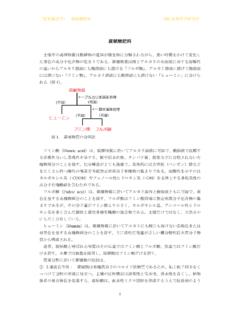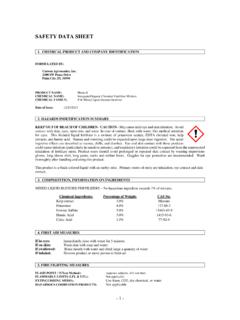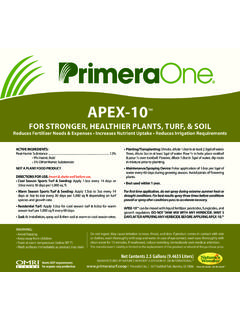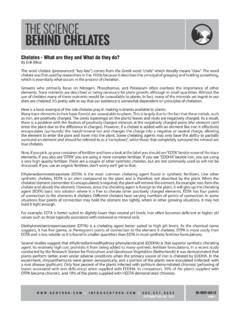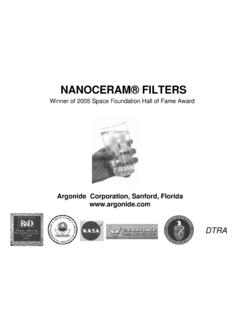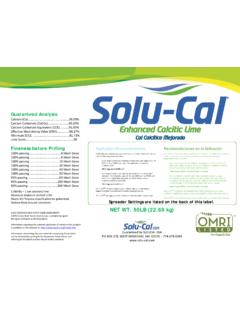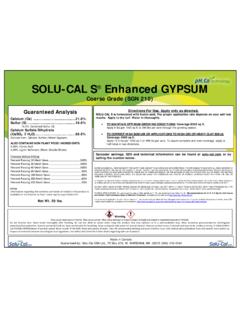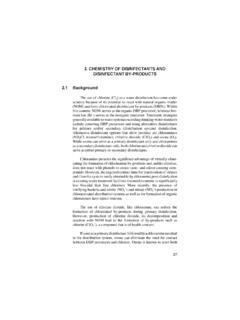Transcription of Buying and Applying Mycorrhizal Fungi - JH Biotech
1 Buying and ApplyingMycorrhizal Fungiby Donald LesterThere are many species of Fungi , bacteria, viruses and protozoa commercially available for the biological control of insects, diseases and weeds. Some products offer mixtures of various organisms. This article will cover one particularly easy-to-use type of Fungi that helps control soil diseases and makes otherwise unavailable soil nutrients available to plants this Fungi is known as Fungi are a group of Fungi that live on and within plant roots in a symbiotic or mutually beneficial relationship. The fungus attaches itself to the plant root and then grows out into the soil with very fine roots or mycelium. These Mycorrhizal root systems increase the absorbing area of plant roots 10 to 1,000 times thus greatly improving the ability of plants to utilize soil resources.
2 In return the fungus receives finished product in the form of carbohydrates, proteins and sugars. Mycorrhizal Fungi are able to absorb all of the 15 major macro and micro nutrients required for plant growth. Mycorrhizal Fungi release powerful chemicals into the soil that dissolve hard to capture nutrients such as phosphorus. It does this so well that mycorrhizae do not perform well in phosphorus rich soils. This phenomenon is particularly important in plant nutrition and explains why non- Mycorrhizal plants require higher levels of fertility to maintain their health. 126 MAXIMUM YIELD USA - September 2009" Mycorrhizal Fungi release powerful chemicals into the soil that dissolve hard to capture nutrients such as phosphorus."127 MAXIMUM YIELD USA - September 2009 Moreover, this extended root system is very important for water uptake and storage.
3 In non-irrigated conditions, plants inoculated with mycorrhizae are under far less drought stress compared to untreated 95 per cent of crops not only respond positively to colonization by Mycorrhizal Fungi , but they may suffer in the absence of mycorrhizae (Kendra Baumgartner, USDA California). Mycorrhizal Fungi in nature are lost due to soil disturbances such as mining, construction or erosion; strong acid or chemical treatments; pesticides, excessive heat, drought or flooding; and denial of oxygen or water by asphalt, concrete, soil compaction and roads. In indoor gardens mycorrhizae must be introduced into sterilized soils and maintained because of losses due to the use of strong sterilizers, waterlogged soils low in oxygen and excessive fertilization. Mycorrhizae work well within integrated pest management (IPM) programs and organic programs; are effective in resistance management; break down crop residue thus freeing up valuable nutrients for plants; and are non-burning and non-phytotoxic to are two main types of mycorrhizae: ecto and Fungi , also known as AM (arbuscular mycorrhizae): This group of Mycorrhizal Fungi is important in non-woody plants, including many agricultural crops, grasses and turf.
4 They are sometimes called vesicular-arbuscular mycorrhizae (VAM) due to specialized structures that the fungus creates. Although this type of mycorrhizae invades plant roots it does not harm the Fungi : This group of Mycorrhizal Fungi grows between root cells and forms a sheath or mantle around plant roots, but it does not actually invade the plant cells. They are important to many woody perennials, bushes, shrubs and is a great potential for the use of Mycorrhizal Fungi as inoculants especially in the production and protection of high-value greenhouse-grown crops or transplanted vegetable crops such as tomatoes and other bedding plants. If using mycorrhizae as a control rather than preventative it is best to treat infections early. If mycorrhizae are applied too late then Mycorrhizal Fungi on results will be disappointing.
5 Mycorrhizae are not a miracle control, but with proper usage and realistic expectations you can have Mother Nature working for are some general guidelines for using mycorrhizae in various greenhouse and hydroponic environments. As with any product, strict adherence to the label instructions is necessary for optimum systems are a more highly aerated environment than traditional hydroponics and have proven to be an excellent system for growing mycorrhizae without a physical substrate. This system allows the grower to actually see the Fungi growing on root surfaces. Liquid formulations of mycorrhizae can be added to the nutrient solution and delivered through the misting system directly to the roots. Some filtering of the liquid before application may be required to prevent nozzle into ContainersApply granules or liquid formulation directly into the planting hole making sure that the root ball has good contact with the mycorrhizae.
6 Some products come in convenient biodegradable teabags or sachets as they are known in Europe that can be dropped into the planting hole making application quick and easy. As the plants grow maintenance applications can be applied as soil drenches. Bulk granular formulations can be placed in a sock or similar material and soaked for several hours to release the organisms and activate them. This liquid can then be used as a soil drench for maintenance applications as the season with growing MediaMany commercial potting mixes already contain Mycorrhizal Fungi incorporated into them. However, bulk granules of mycorrhizae can be mixed in with the soil before transplanting or being applied to the soil surface after transplanting much like a granular fertilizer. Incorporation of Mycorrhizal Fungi is especially important in sterilized soils to regain a population of beneficial micro-organisms to out-compete pathogens.
7 Bark, calcined clay, expanded clay and perlite provide good aeration. Peat and vermiculite hold more water and allow air to penetrate better than sand. Mycorrhizae are aerobic, meaning that they require oxygen. They can grow in anaerobic or reduced oxygen environments like rice, but their populations are greatly reduced in these environments. So it is best not to waterlog the media for too rootBare root plants can be dipped into solutions containing Mycorrhizal Fungi that have been pre-activated. Mycorrhizal Fungi are compatible with most common commercial rooting powders and water-absorbent gels. The teabag formulations can be soaked in water just like a regular teabag and the solution used for dipping. Granules can also be soaked in water for a few hours with the water being used as a base for a dipping solution as CubesThere are basically four kinds of starter cubes: rockwool, oasis cubes, organo-cubes and peat pots.
8 The most favored types are rockwool, organo-cubes and oasis cubes as they retain water well and also hold enough air so that the medium does not stay too the starter cubes varies with the kind of starter cube you are using. Organo-Cubes come ready for use. The oasis and peat pot cubes should be pre-soaked with water that is adjusted to pH - The cubes need to be saturated and then allowed to drain. The cubes are now ready to use. Rockwool has a high pH and as a result must be treated differently. Rockwool cubes must be pre-soaked with water that is pH adjusted to This low pH acid solution will balance the overall pH to a level that plants require. The cubes should be soaked for about 24 hours and then drained. They are then ready for the starter cubes are prepared you can plant the seed and apply Mycorrhizal Fungi .
9 Gently cover the seed by packing some of the seed cube material from around the hole over the CultureMycorrhizae, especially Glomus sp., do very well in sand culture systems through which recycled nutrient solution is passed several times a day (Ojala and Jarrell 1980). Simply inoculate the nutrient reservoir with mycorrhizae according to the label. Be careful in the use of strong compost teas or other green manure materials as food sources for mycorrhizae because the low pH of these materials can adversely affect mycorrhizae Buying and Applying Mycorrhizal FungiThe teabag formulations."The use of molasses and other sugars as a Mycorrhizal food source can stimulate pathogen development." 128 MAXIMUM YIELD USA - September 2009growth. Similarly, the use of molasses and other sugars as a Mycorrhizal food source can stimulate pathogen development.
10 Using humic acid as a carbon food source will help the mycorrhizae, and the soil-binding nature of humic acid will help build structure in the BagsMycorrhizae can be incorporated into sawdust bags. The bag should be presoaked with nutrient solution 48 hours prior to setting the plants out in the bags. Transplant as usual with mycorrhizae pre-mixed in the sawdust or with mycorrhizae placed in the immediate vicinity of the root can be put in direct contact with mycorrhizae at planting time. This ensures that the young roots are colonized early on for protection against water mold root rots like Pythium and Phytophthora. However, be sure that the mycorrhizae are compatible with any fungicides that may be applied with the seed or used as a seed need carbon as a food source. humic acids are a concentrated organic matter and are often used to supplement mycorrhizae in soil systems.
